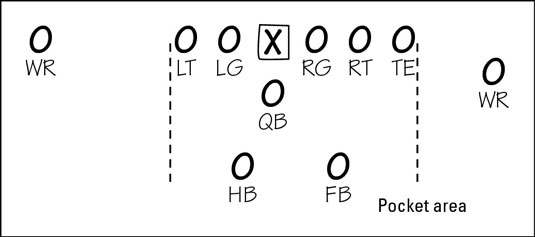Ever heard the term “pocket passer” or “inside/outside the pocket” and started to look for something that might appear on a pair of Levi’s? Those terms are referring to where a quarterback is standing when he throws the football – or more specifically, the location of an invisible box and where a quarterback is standing in reference to that box when he’s throwing the football.
Football. It gets more like Harry Potter every day.
The pocket is a term used to describe the distance between the furthest offensive linemen – this includes the tight end if he’s blocking with the offensive line and not running a route to catch a pass. To be technical about it – widthwise, the pocket encompasses the space 2 yards beyond the furthest linemen and lengthwise, it’s as far back as the offense’s end zone.
Let’s incorporate a visual to help put the pocket puzzle together:
(Need a refresher on the positions shown above? Check out this post.)
Why is that box called a pocket? As the play unfolds, the offensive linemen will curve into a horseshoe shape to protect the quarterback from oncoming defenders – a shape that also looks like a pocket.
Traditionally, quarterbacks tend to stay within the protection of the pocket – hence the reason why some quarterbacks are referred to as “traditional pocket passers.” But modern running quarterbacks tend to take their chances and bolt for rushing yards or passing opportunities outside of the pocket.
Last week we learned that the location of the pocket becomes important when intentional grounding is in question. Intentional grounding is a penalty called against a quarterback when he throws a pass that is inside the pocket, short of the line of scrimmage, and in a location devoid of eligible receivers.
This might sound like a dumb question but it’s one I had for a long time – for the purposes of intentional grounding, is the pocket defined as the space between the furthest linemen before the snap or during the play?
It’s the latter. The pocket is constantly changing due to the positions of the linemen (or blocking tight end), so the call depends on where they are at the time of the pass, not on where they were when the play started.
Make sense?




